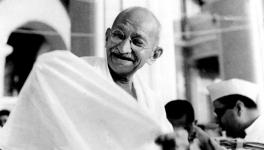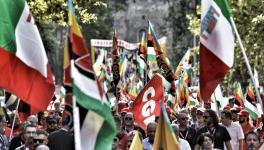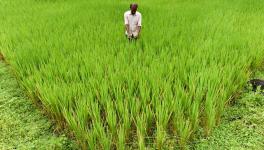Hunger Stalks the United States

Kayla, PSL Member and Liberation Center Volunteer, poses with a neighbor after distributing groceries. Photo: Philadelphia Liberation Center
According to the United Nations, the world produces enough food to feed 10 billion people. Yet this year, even in the United States, the world’s richest country, 1 in 3 American families with kids went hungry. Even before the pandemic, in 2019, official statistics from the United States Department of Agriculture (USDA) detailed that 35 million people went hungry–10 million of them children.
The COVID-19 pandemic supercharged the situation, exposing even those who felt “secure” to the possibility of going without eating. In a society where food is not a human right but a good to be purchased, how were people supposed to eat if they couldn’t work?
The short answer: they didn’t. Receiving almost no help from the federal government, working people in the United States were laid off by the millions. Overnight, people suddenly found themselves wondering where their next meal would come from. Families were forced to choose between buying life saving medications and buying enough food to feed their families.
In fact, in early summer 2021, 63 million people in the United States told government investigators that they were unable to pay for their usual household expenses, in particular the balance between food and rent but also including student loans and medicines.
The burden is also shared unevenly, Black adults were three times likelier, and Latino adults were more than two times likelier, than white adults to report being food-insufficient.
The struggle to survive
This was the context out of which the US (Unity and Survival) Program was born in the city of Philadelphia, a representative example of the type of “mutual aid programs” that sprung up across the United States during the pandemic. The initiative, launched by the Philadelphia Liberation Center, aimed to fulfill the duties that the government had failed to carry out during the global pandemic. The US program had a straightforward task: identify Philadelphia residents who were struggling to acquire food, deliver it to them and build a more dense community network to mobilize in defense of the right to life.
A delivery network in particular was a crucial element to the program, as one volunteer organizer Nilda noted:
“There was a high degree of fear and uncertainty and a reluctance on the part of many residents not only in this neighborhood, but I’m sure throughout the city and the nation to expose themselves to the COVID virus. With so many seniors and people with chronic health conditions in the area, we felt that we needed to organize not just the supplies, but the network to distribute them.”
Initially, organizers of the US program sought food donations and created a Gofundme to pay for groceries. Gofundme became a popular way for people to finance basic needs like food and medical costs during the pandemic, since government support was insufficient. The US program provided crucial assistance to families in precarious positions during this early period, which garnered the program nationwide attention and support.

US Program volunteers pose with boxes while packing up groceries for distribution. Photo: Philadelphia Liberation Center
Within months, the US program caught the attention of non-profit groups in the city, who began donating food boxes to the program, significantly increasing the amount of food delivered. The program also expanded its reach by adding community members to the delivery teams.
Organizers of the US program identified community leaders and food box recipients who were interested in supporting the US program and made them “block captains.” The block captains were responsible for making sure food boxes with groceries were delivered to their own neighborhoods, thus multiplying the reach of the US program.
One notable factor of the block captain network is the importance of a familiar, trusted face, which helps overcome the shame that comes along with seeking assistance in a society with extremely individualistic, “up by the bootstraps” ethos. As “Boogie” one block captain noted:
“My biggest goal when passing out food is for people to get the resource that they need without feeling judged by it, without having any kind of barriers.”

Philadelphia Liberation Center volunteer poses with a neighbor after distribution. Photo: Philadelphia Liberation Center
The Liberation Center was also able to mobilize support from community organizations they had worked with in the past in a variety of social struggles. For instance, they teamed up with the Norris Square Community Action Network, active in anti-gentrification struggles. They also reached into the faith community, partnering with a church, La Vid Verdadera, where members of the Liberation Center were already working tutoring Central American immigrants as part of a joint community education program, Escuelita Óscar Romero.
The Philly Liberation Center estimates that they have delivered 100,000 meals so far, a number that is still growing every week. At its height, the US program was serving 1,000 families every week and is currently serving 750 families, which underscores the continued persistence of hunger, even with a slight easing of the pandemic in the United States.
As Mike, another US program organizer, related:
“We’re getting to a point now where we can get a steady stream of food and supplies, which is amazing because just five months ago we had very limited means at our disposal, and we’ve now gotten to a point where we can look to grow this program even further.”
System change, not charity
Members of the Philadelphia Liberation Center were proud of the apparatus they had built, but they all said the same thing about its weaknesses: it wasn’t big enough to meet the scale of the problem. Although the program was able to feed tens of thousands of people in Philadelphia, there are tens of millions of people going hungry in the United States. The US program gives us a glimpse of what’s possible but it would have to be scaled out on a level only state authorities can reach to significantly reduce poverty in any way. The US program demonstrated that Philadelphia residents are ready and willing to work towards food sovereignty in their city; what’s lacking is the political will.
This is why the US program actively challenges the notion that food can be bought and sold for profit, in their literature and outreach. Detailing that this is the very reason hunger exists in the first place.

Philadelphia Liberation Center volunteer Mecca poses with Nilda of the Norris Square Community Action Network. Photo: Philadelphia Liberation Center
Something that was clear During the peak of the pandemic last year. When videos of farmers dumping unsold milk and crushing unwanted vegetables with tractors went viral. From the perspective of a profit centric system, the crops were worthless because they couldn’t be sold.
Destroying crops makes sense if your goal is maximizing profits, but it makes no sense if your goal is to end hunger. There is no incentive to create sustainable food production and delivery structures under capitalism, in fact, 40% of all food produced in the United States ends up in the trash.
Reflecting on these realities, Hope, another program volunteer, told BreakThrough:
“You know, that’s why we’re socialists. We believe that only the working class can take care of itself, the bourgeoisie, they’re not going to suddenly get kind and decide to be charitable when, when they become charitable, it’s only for their own preservation.”
An end to hunger, as the US program emphasizes, can be possible only by embracing a socio-economic system that is intended to maximize human well-being, not profit for a few.
Hunger in the World is a collaborative series produced by ARG Medios, Brasil de Fato, Breakthrough News, Madaar, New Frame, Newsclick and Peoples Dispatch.
Check out the full length documentary on the Unity and Survival program produced by Breakthrough News:
Get the latest reports & analysis with people's perspective on Protests, movements & deep analytical videos, discussions of the current affairs in your Telegram app. Subscribe to NewsClick's Telegram channel & get Real-Time updates on stories, as they get published on our website.
























